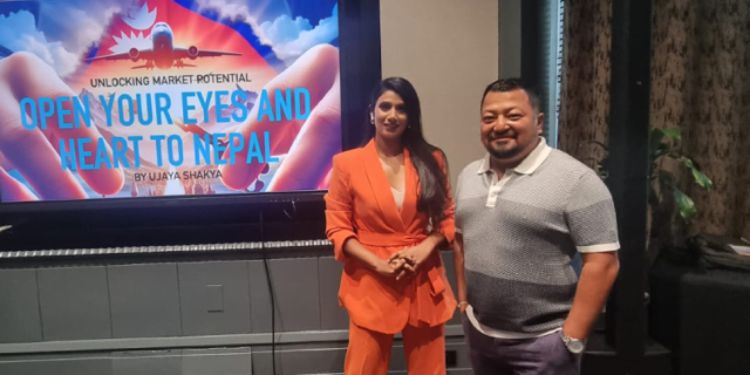Speaking at Goafest 2024, Outreach Founder Mr. Ujaya Shakya began by asking the audience what comes to mind when they think of Nepal. He mentioned common associations like the Himalayas, Mount Everest, Lord Buddha, the Pashupatinath temple, Thamel’s nightlife, and Bollywood actress Manisha Koirala. However, he stressed that modern Nepal is much more than these. Nepal’s identity is rapidly evolving, blending tradition and modernity. It boasts diverse cultures, languages and ethnicities. The mountainous regions are influenced by Buddhism, while the Terai plains share cultural ties with Indian Hinduism. Cities like Kathmandu and Pokhara harmoniously blend Buddhist and Hindu traditions.
He showcased several success stories of modern Nepali individuals making significant impacts globally. He mentioned a Nepali fashion designer, Prabal Gurung based in New York who has dressed Michelle Obama on multiple occasions. Shreya Giri and Kajol Sethia, who featured in the 2024 Forbes Under 30 list, representing young Nepali achievers. Santosh Shah, a runner-up in UK MasterChef, has brought global attention to Nepali cuisine, making traditional Nepali dishes go global. Nirmal Purja, also known as Nims Dai, gained international fame with his documentary “14 Peaks,” released on Netflix in 2021. His achievements in mountaineering have inspired many and established him as an international adventure celebrity. Surakashya Pant made history by becoming the first Nepali actress to walk the red carpet at the Cannes Film Festival, showcasing the growing influence of Nepali talent in the global entertainment industry. These achievements illustrate that modern Nepali are not confined by borders but are making significant contributions globally, reflecting a progressive youthful spirit. He also highlighted that starting next week, the Nepal Men’s Cricket team, led by the young captain Rohit Paudel, who is just 21 years old, will be playing in the ICC Men’s T20 World Cup in the USA. He wished them the best as they compete with top cricket nations, including India, showcasing the rising potential of Nepali athletes on the international stage.
He emphasized that significant advancements in Nepal’s infrastructure and economy are paving the way for a better future. The retail sector is rapidly growing, with Bhatbhateni Supermarket operating 26 stores nationwide, offering over 70,000 products from 1,000 suppliers. Other multi-chain stores like Big Mart and Salesberry also reflect this modern trade expansion, driven by Nepal’s growing middle class. The “Tourism Decade 2023-2032” initiative aims to create one million jobs and boost tourism’s GDP contribution to 10%. With 27 new five-star hotels under construction, Nepal is enhancing its appeal as a global tourist destination, offering more luxury accommodations and services to attract international visitors. Nepal plans to generate over 10,000 MW of power in the next decade. This ambitious goal will not only meet domestic energy needs but also position Nepal as a key energy exporter in the region. With 70% of the population being of working age, there is a rise in middle-income families. Remittances contribute 24% to Nepal’s GDP, reflecting a vibrant migrant ecosystem focused on improving family lifestyles, better homes and education for their children. The IT services sector is growing, now contributing 2% of GDP from the organized sector.
He emphasizes that a significant aspect of modern Nepal is its youthful population, with 72% of its inhabitants under the age of 35. This demographic is shaping the country’s future with their ambition, which often surpasses what the country has to offers. Many young Nepalis are not only venturing abroad as migrant workers but also seeking higher education to learn the best practices, reflecting their aspirations for personal and national development. This resilient spirit was notably evident after the 2015 earthquake, showcasing their commitment to rebuilding the nation. This youthfulness finds expression in the leadership of Kathmandu’s Mayor Balen Shah, a 34-year-old rapper and Deputy Mayor Sunita Dangol, a 31-year-old biotechnologist and activist. Their election symbolizes the openness to positive change and the potential of youth to drive progress.
For brands aiming to connect with the Nepali market, understanding this dynamic landscape is crucial. Successful brands align themselves with causes and movements that resonate with national pride and youth culture. Domestic brands like Arna Beer and Gold Star Shoes exemplify this. Arna Beer disrupted the market dominated by global brands by catering to youth culture with smaller high-alcohol packs. They leverages Nepali music, TikTok and cricket to engage with the younger demographic effectively. Gold Star Shoes, a 50-year-old brand in Nepal, revitalized its image few years ago to appeal to youth culture. It transformed from a mass, cheaper, unfashionable brand to a cult favorite by embracing youthful trends.
Brands that can strike a balance between global best practices and local cultural values stand to gain the loyalty of Nepali youth, who have a strong sense of cultural pride. Globalization and digital connectivity have exposed them to diverse perspectives, yet they remain deeply rooted in their traditions. By resonating with these values, brands can build strong emotional connections with the younger population in Nepal.
Many global brands, including Sunsilk, Dove, Close-up, Ncell, Mountain Dew, Samsung, Center Fruits, Coca-Cola, Tata, PubG, and Korean Noodle Brand Nongshim, have achieved great success by embracing “Nepalisation” in their campaigns. He highlighted key success stories from these brands, showcasing how their marketing campaigns resonated with local culture and connected with the Nepali audience. They have adopted strategies that resonate with local culture, reflecting the youthful energy and cultural pride of modern Nepal. These brands have launched youth-centric campaigns featuring Nepali celebrities and relatable stories from Nepali society, effectively engaging with local culture and strengthening their connection with the Nepali audience.
In modern Nepal, the young population takes pride in the diversity of cultures, traditions and Nepali heritage. Brands that strike a balance between global best practices and local cultural values stand to gain the loyalty of this demographic. As Nepal continues to evolve, it remains deeply rooted in its heritage while confidently embracing the opportunities of the modern world, driven by its youthful population.

















